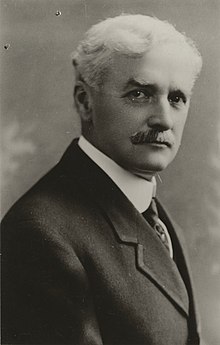
San Marino is a city in Los Angeles County, California, United States. It was incorporated on April 25, 1913. At the 2020 United States census the population was 12,513, a decline from the 2010 United States census.

The Pacific Electric Railway Company, nicknamed the Red Cars, was a privately owned mass transit system in Southern California consisting of electrically powered streetcars, interurban cars, and buses and was the largest electric railway system in the world in the 1920s. Organized around the city centers of Los Angeles and San Bernardino, it connected cities in Los Angeles County, Orange County, San Bernardino County and Riverside County.

Henry Edwards Huntington was an American railroad magnate and collector of art and rare books. Huntington settled in Los Angeles, where he owned the Pacific Electric Railway as well as substantial real estate interests. In addition to being a businessman and art collector, Huntington was a major booster for Los Angeles in the late 19th and early 20th centuries. Many places in California are named after him.
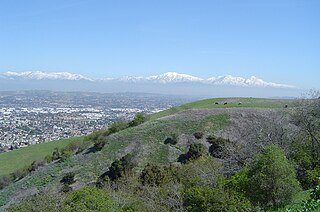
The San Gabriel Valley, often referred to by its initials as SGV, is one of the principal valleys of Southern California, with the city of Los Angeles directly bordering it to the west, and occupying the vast majority of the southeastern part of Los Angeles County. Surrounding landforms and other features include the following:

Benjamin Davis Wilson, commonly known as Don Benito Wilson, was an American-Mexican politician, fur trapper, and ranchero of California. Born in Tennessee to parents from Virginia, Wilson eventually settled in Alta California when it was part of the Republic of Mexico, and acquired Rancho Jurupa. He became a naturalized Mexican citizen and married into a prominent Californio family.

Alfred Beck Chapman was a Los Angeles real estate attorney and investor. He was one of the founders of the city of Orange, California.
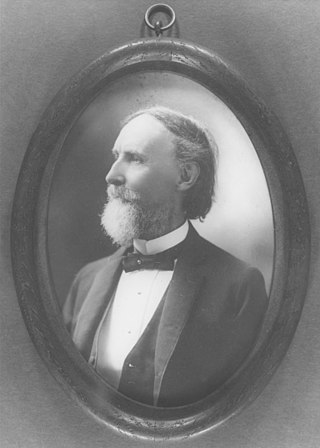
Andrew Glassell Jr. was an American real estate attorney and investor. He was one of the founders of the city of Orange, California.

William Thornton Glassell was an officer in the Confederate States Navy during the American Civil War. He laid out the city of Orange, California.
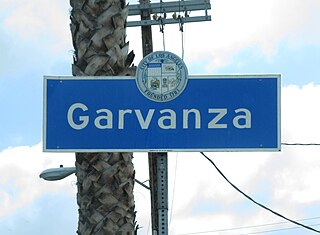
Garvanza is a neighborhood in northeast Los Angeles. Fourteen Los Angeles Historic-Cultural Monuments are located in the neighborhood.
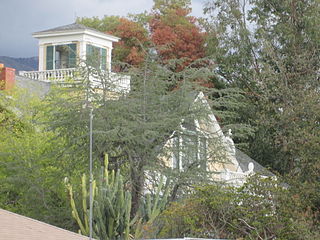
Crank House, also known as Fair Oaks Ranch, is an 1882 Victorian style residence in Altadena, Los Angeles County, California. The house was placed on the National Register of Historic Places in 1997 for its association with the early settlement of Altadena. (site #97000751). The house has notably featured in films such as Hocus Pocus, Matilda, Scream 2 and Catch Me If You Can.
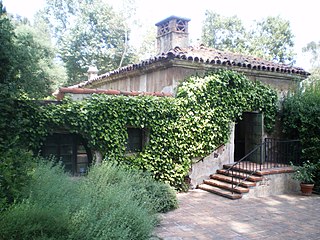
El Molino Viejo, also known as The Old Mill, is a former grist mill in the San Rafael Hills of present-day San Marino, California, United States, and was built in 1816 by Father José María de Zalvidea from the Mission San Gabriel Arcángel. It is the oldest commercial building in Southern California, and was one of the first ten sites in Los Angeles County to be listed on the National Register of Historic Places, receiving the recognition in 1971. The Old Mill has also been designated as a California Historical Landmark.
Susan Thornton Glassell was the wife of Col. George Patton and later of Col. George H. Smith, the sister of Andrew Glassell and the paternal grandmother of Gen. George S. Patton.
George H. Smith was a Confederate Civil War veteran and prominent Los Angeles lawyer, judge and politician.
Pasadena is a city in Los Angeles County, California, United States. Founded in 1874 and incorporated in 1886, the city is famous for its colorful history and for the hosting of both the Tournament of Roses Parade and the annual Rose Bowl game football game. It is also the home of the world-renowned California Institute of Technology (Caltech) and Jet Propulsion Laboratory (JPL)

Colonel George Patton Sr. was a Confederate colonel during the American Civil War. He was the grandfather of World War II General George S. Patton. George Patton was also the great-grandfather of Major General George Patton IV, who died in 2004.
Glassell is a surname. Notable people with the surname include:

The Los Angeles and San Gabriel Valley Railroad was a railroad founded on September 5, 1883, by James F. Crank with the goal of bringing a rail line to Pasadena, California from downtown Los Angeles, the line opened in 1886. Los Angeles and San Gabriel Valley Railroad was sold and consolidated on May 20, 1887 into the California Central Railway. In 1889 this was consolidated into Southern California Railway Company. On Jan. 17, 1906 Southern California Railway was sold to the Atchison, Topeka and Santa Fe Railway and called the Pasadena Subdivision. The main line closed in 1994. The railroad later reopened as the MTA Gold Line Light Rail service in July 2003.

The California Central Railway was incorporated on April 23, 1887, with headquarters in San Bernardino, California. George O. Manchester was the President of the corporation.

Pasadena Republican Club (PRC) is the oldest, continuously active Republican political club in America, founded on March 29, 1884, 140 years ago. Every two years for the last 140 years the Pasadena Republican Club has operated the Greater Pasadena Area Republican Headquarters in Pasadena, California with the help of volunteers. Greater Pasadena Area Republican Headquarters supports the towns in the west side of the San Gabriel Valley. Pasadena Republican Club works closely with Republicans running for office of the California's 41st State Assembly district.
Richard H. Lacy was an American businessman, politician, and pioneer of San Marino, California, serving as its longtime mayor for 18 years. Prior to his election as mayor, Lacy was a major industrialist, oil tycoon, and real estate developer in the Los Angeles area and city councilman.
